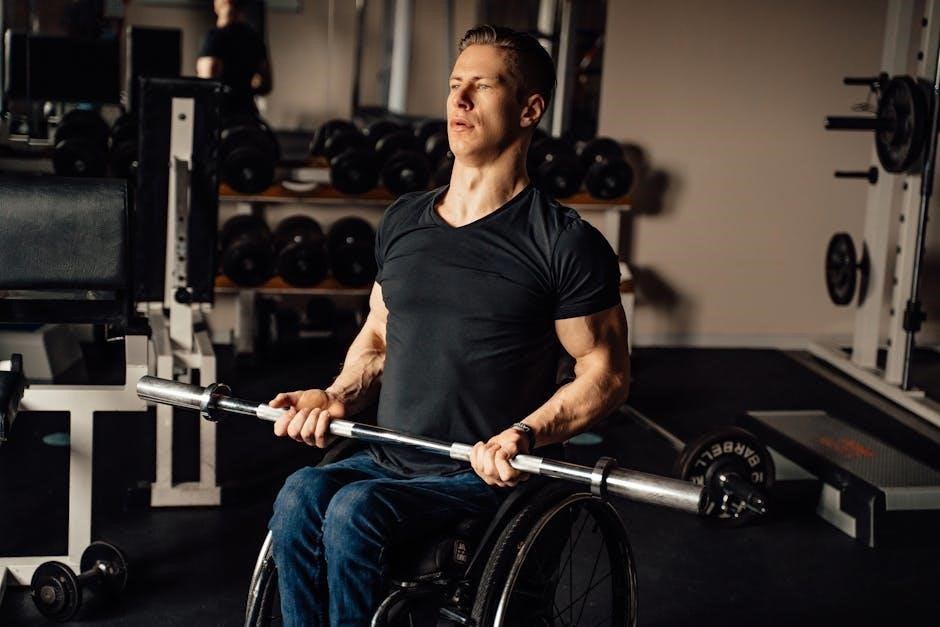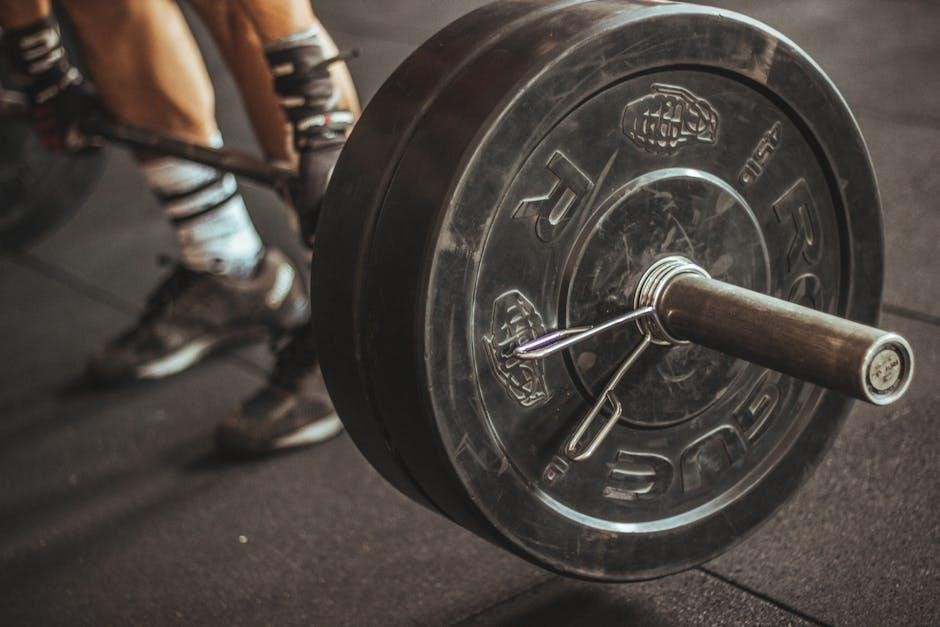Basketball demands a comprehensive strength and conditioning program, often detailed in PDF guides, focusing on player needs and maximizing on-court performance․
Resources like Shop․StrongerTeam․com offer valuable strength training materials, emphasizing safety, efficiency, and intensity for optimal athlete development․
A well-structured plan, accessible through various basketball strength and conditioning PDFs, is crucial for injury prevention and athletic longevity․
The Importance of a Dedicated Program
A dedicated strength and conditioning program is paramount for basketball players, extending beyond simply practicing the sport․ Accessing resources like basketball strength and conditioning PDFs provides structured plans for holistic development․
These programs address crucial areas – from foundational strength, as highlighted in Womens Health’s weight training plans, to explosive power vital for vertical jumps․ Ignoring resistance training, as noted by statistics, can hinder potential․
Michigan’s approach, centered around practice, underscores the integration of conditioning․ A focused regimen, often found in downloadable PDF formats from sites like Shop․StrongerTeam․com, minimizes injury risk and maximizes performance gains, ultimately shaping successful athletes․
Target Athlete Profile: Needs and Demands
Basketball players require programs tailored to their unique demands, often outlined in detailed strength and conditioning PDFs․ Considerations include position – forwards like Terry Allen benefit from specific weightlifting, while guards need agility․
Rapid acceleration, deceleration, and jumping are key, necessitating plyometric training and lower body strength․ A PDF guide should address these, alongside core stability for injury prevention․
Young athletes, like Obieze Moneke, require age-appropriate programs․ A comprehensive plan, accessible through resources like Shop․StrongerTeam․com, must balance strength gains with proper technique and recovery, optimizing performance and longevity․

Pre-Season Strength and Conditioning (4-6 Weeks)
Pre-season training, detailed in basketball strength and conditioning PDFs, focuses on building a foundation for the demands of the upcoming season․
This phase prepares athletes through anatomical adaptation and strength endurance, crucial for injury prevention and peak performance․
Phase 1: Anatomical Adaptation
Phase 1, outlined in many basketball strength and conditioning PDFs, prioritizes preparing the body for more intense training loads․ This initial 1-2 week period centers on foundational movements, building work capacity and addressing movement deficiencies․
The focus isn’t maximal strength, but rather enhancing tissue quality, joint mobility, and establishing proper movement patterns․ Expect exercises like bodyweight squats, lunges, and core stability work․
This phase minimizes injury risk by reinforcing correct mechanics before adding significant external resistance, setting the stage for subsequent phases․
Focus on Foundational Movements
Foundational movements, detailed within basketball strength and conditioning PDFs, form the bedrock of any effective program․ These include squatting, hinging, pushing, pulling, and carrying – mirroring actions seen on the court․
Initially, prioritize mastering technique with bodyweight before introducing external loads․ This ensures proper muscle activation and minimizes injury potential․ Expect variations like goblet squats, push-ups, and bodyweight rows․
These movements build a base of strength and stability, preparing athletes for more complex, sport-specific exercises later in the training cycle․
Core Stability and Mobility Exercises
Core stability and mobility, often outlined in basketball strength and conditioning PDFs, are paramount for transferring power and preventing injuries․ Exercises should address all planes of motion․
Implement anti-rotation exercises like Pallof presses and planks to resist twisting forces․ Dynamic stretching and foam rolling enhance mobility in the hips, ankles, and thoracic spine․
Prioritize exercises that mimic basketball movements, such as rotational core work and single-leg balance drills․ A strong, mobile core improves agility and overall athletic performance․
Phase 2: Strength Endurance
Phase 2, detailed in many basketball strength and conditioning PDFs, focuses on building strength endurance – the ability to repeatedly exert force over time․ This is vital for sustained high-intensity play․
Circuit training, incorporating basketball-specific movements, is highly effective․ Utilize bodyweight exercises and light resistance, emphasizing proper form and controlled tempo․
Sample circuits might include push-ups, lunges, squats, and plyometric jumps, performed for multiple rounds with minimal rest․ This phase bridges anatomical adaptation to more intense strength work․
Circuit Training for Basketball-Specific Fitness
Circuit training, often outlined in basketball strength and conditioning PDFs, mimics the demands of the game, improving cardiovascular fitness and muscular endurance simultaneously․ Design circuits with movements mirroring basketball actions․
Include exercises like defensive slides, jump stops, cone drills, and medicine ball throws․ Focus on short bursts of high-intensity effort followed by brief recovery periods․
Adjust the circuit based on player position and fitness level․ Resources from sites like Shop․StrongerTeam․com provide example circuits and progressions for optimal results․
Bodyweight and Light Resistance Training
Bodyweight exercises and light resistance training, frequently detailed in basketball strength and conditioning PDFs, are foundational for building a base level of strength and stability․ These methods are accessible and minimize injury risk․
Focus on exercises like push-ups, squats, lunges, planks, and glute bridges․ Incorporate resistance bands for added challenge and versatility․ These are ideal for pre-season or in-season maintenance․
Many PDF resources emphasize proper form and controlled movements․ Shop․StrongerTeam․com offers guides demonstrating correct technique for maximizing effectiveness and preventing injuries․

In-Season Strength and Conditioning (Maintenance)
Basketball players require a maintenance program, often outlined in PDF guides, prioritizing strength retention with reduced volume and increased intensity during competition․
Focus shifts to injury prevention through dynamic warm-ups and corrective exercises, detailed in available strength and conditioning PDFs․
Maintaining Strength Levels During Competition
Maintaining peak strength during the basketball season requires a strategic shift in the strength and conditioning program, often detailed in comprehensive PDF resources․ The focus transitions from building strength to preserving it amidst the demands of frequent games and travel․
Typically, this involves a reduction in overall training volume – fewer sets and reps – coupled with an increase in intensity․ This approach ensures players don’t experience excessive fatigue that could compromise performance or increase injury risk․
PDF guides from sources like Shop․StrongerTeam․com emphasize prioritizing exercises that directly translate to on-court movements, ensuring that strength gains are functional and applicable to the game․ Careful monitoring of player fatigue and individualized adjustments are also crucial components of a successful in-season maintenance plan․
Reduced Volume, Increased Intensity
Basketball players, during competition, benefit from a strength and conditioning approach outlined in many PDF programs, prioritizing quality over quantity․ This means significantly reducing the overall training volume – decreasing the number of sets, reps, and even training days – to combat fatigue․
Simultaneously, intensity is deliberately increased․ This involves lifting heavier weights (while maintaining proper form) or performing more challenging variations of exercises․ The goal is to stimulate the neuromuscular system and preserve strength gains without causing excessive muscle breakdown․
Resources like those found at Shop․StrongerTeam․com emphasize this principle, advocating for focused, high-effort sessions that minimize time commitment while maximizing impact on performance․
Injury Prevention Strategies
A robust basketball strength and conditioning program, often detailed in comprehensive PDF guides, prioritizes injury prevention as a core component․ This involves proactive measures to address common vulnerabilities in players․
Dynamic warm-up routines are essential, preparing muscles and joints for the demands of the game․ Corrective exercise, targeting identified muscle imbalances, is also crucial․ These strategies, frequently outlined in resources like those at Shop․StrongerTeam․com, aim to enhance stability and movement patterns․
By strengthening supporting muscles and improving flexibility, athletes can significantly reduce their risk of sprains, strains, and other basketball-related injuries․
Dynamic Warm-up Routines
Effective basketball strength and conditioning programs, often detailed in PDF resources, emphasize dynamic warm-ups to prepare athletes for intense activity․ These routines differ from static stretching, focusing on controlled movements through a full range of motion․
Examples include leg swings, arm circles, torso twists, and walking lunges, progressively increasing heart rate and blood flow to muscles․ A well-designed warm-up, as found in guides from Shop․StrongerTeam․com, enhances performance and reduces injury risk․
Prioritizing dynamic movements mimics game actions, optimizing neuromuscular readiness for explosive plays․
Corrective Exercise for Common Basketball Injuries
Basketball strength and conditioning programs, often outlined in detailed PDF guides, must incorporate corrective exercises to address common injury patterns․ Ankle sprains, knee pain, and shoulder imbalances are prevalent among players․
Targeted exercises, like band walks for knee valgus or rotator cuff strengthening, restore proper movement mechanics and stability․ Resources from platforms like Shop․StrongerTeam․com provide specific protocols․
Proactive implementation of these exercises minimizes risk, enhances recovery, and promotes long-term athletic health, ensuring players remain on the court․

Post-Season Strength and Conditioning (Recovery & Rebuild)
PDF resources detail post-season plans prioritizing active recovery and rehabilitation, addressing muscle imbalances to prepare athletes for future demands․
Strategic deloading and focused exercises rebuild strength and prevent stagnation, setting the stage for renewed performance gains․
Active Recovery and Rehabilitation
PDF guides emphasize active recovery post-season, moving beyond complete rest to promote blood flow and reduce muscle soreness․ This includes low-intensity activities like swimming or cycling, facilitating waste removal and accelerating tissue repair․
Rehabilitation protocols, often outlined in detailed basketball strength and conditioning PDFs, address lingering injuries or overuse issues․ Corrective exercises and targeted therapies restore optimal movement patterns and prevent re-injury․
Prioritizing flexibility and mobility through dynamic stretching and foam rolling is also crucial, ensuring a full range of motion and preparing the body for the next training cycle․ A phased approach is key, gradually increasing intensity as the athlete recovers․
Addressing Muscle Imbalances
Basketball strength and conditioning PDFs frequently highlight the importance of identifying and correcting muscle imbalances․ These imbalances often develop due to the sport’s unilateral demands – repetitive movements on one side of the body․
Comprehensive assessments, detailed within these resources, pinpoint weaknesses in stabilizing muscles, particularly around the hips, knees, and shoulders․ Targeted exercises, like single-leg work and rotational movements, restore balance․
Ignoring imbalances increases injury risk․ A proactive approach, guided by a well-designed program, ensures symmetrical strength and optimal biomechanics, enhancing performance and longevity on the court․

Key Strength Exercises for Basketball Players
Basketball strength and conditioning PDFs emphasize lower body exercises like squats and lunges, alongside upper body work such as bench press and pull-ups․
These foundational movements, detailed in program guides, build power, stability, and athleticism crucial for dominating on the court․
Lower Body Strength
Basketball strength and conditioning PDFs consistently prioritize lower body development, recognizing its pivotal role in jumping, sprinting, and agility․ Squats – back, front, and goblet variations – are fundamental, building overall leg strength and power․
Lunges, including forward, reverse, and lateral versions, enhance single-leg stability and address muscle imbalances․ These exercises, often detailed with progressions in training guides, improve explosive movements․
A robust lower body foundation, cultivated through these exercises, translates directly to improved performance and reduced injury risk on the basketball court, as highlighted in program resources․
Squats (Back, Front, Goblet)
Basketball strength and conditioning PDFs universally feature squats as a cornerstone exercise․ Back squats build maximal strength, crucial for rebounding and post play․ Front squats emphasize quad development and core stability, vital for maintaining balance during drives․
Goblet squats, often recommended for beginners, improve squat mechanics and core engagement․ Proper form, detailed in training materials, is paramount to prevent injury and maximize effectiveness․
Progressive overload – increasing weight or reps – is key to continued gains, as outlined in comprehensive program guides available online, enhancing athletic performance․
Lunges (Forward, Reverse, Lateral)
Lunges are fundamental in basketball strength and conditioning PDFs, developing unilateral leg strength – essential for cutting, jumping, and defensive slides․ Forward lunges mimic game movements, improving stride length and power․
Reverse lunges are knee-friendly, building glute and hamstring strength․ Lateral lunges enhance side-to-side agility, crucial for defensive positioning and quick changes of direction․
Program guides emphasize controlled movements and proper form to prevent injury․ Incorporating variations with dumbbells or resistance bands increases intensity, boosting athletic capabilities․
Upper Body Strength
Basketball strength and conditioning PDFs highlight the importance of upper body strength for rebounding, shooting, and protecting the ball․ Bench press (barbell or dumbbell) builds pushing power, vital for boxing out opponents and finishing strong at the rim․
Pull-ups/chin-ups and rows develop pulling strength, improving shooting mechanics and overall upper body stability․ These exercises enhance core engagement and postural control․
Programs often include variations to address individual needs and prevent plateaus, ensuring continuous gains in strength and power throughout the season․
Bench Press (Barbell, Dumbbell)
Basketball strength and conditioning PDFs consistently feature the bench press – both barbell and dumbbell variations – as a cornerstone of upper body development․ This exercise builds crucial pushing strength, directly translating to improved rebounding ability and powerful finishes around the basket․
Barbell bench press allows for heavier loads, maximizing strength gains, while dumbbells enhance stability and address muscle imbalances․ Proper form is paramount to prevent injury․
Progressive overload, detailed in program PDFs, is key; gradually increasing weight or reps over time to continually challenge the muscles․
Pull-ups/Chin-ups & Rows
Basketball strength and conditioning PDFs emphasize the importance of pulling movements, primarily through pull-ups, chin-ups, and various row variations․ These exercises counteract the pushing motions of the bench press, fostering balanced upper body strength and preventing postural imbalances․
Pull-ups and chin-ups develop back and bicep strength, crucial for rebounding, defending, and shooting․ Rows, using barbells or dumbbells, offer a scalable alternative for athletes unable to perform unassisted pull-ups․
Program PDFs often include progressions to build towards full pull-ups․

Plyometric Training for Basketball
Basketball strength and conditioning PDFs highlight plyometrics for explosive power, including box jumps, depth jumps, cone drills, and shuttle runs, enhancing vertical jump and agility․
Vertical Jump Development
Basketball strength and conditioning program PDFs consistently emphasize plyometrics as a cornerstone for maximizing vertical jump height․ Exercises like box jumps are fundamental, building explosive leg power and reactive strength․
Progressing to depth jumps introduces a more advanced stimulus, utilizing the stretch-shortening cycle to enhance jump performance․ Proper technique, detailed in training guides, is paramount for safety and effectiveness․
These drills, when integrated into a comprehensive program, contribute significantly to an athlete’s ability to rebound, shoot over defenders, and excel in dynamic game situations․ Consistent implementation, guided by reliable PDF resources, yields substantial improvements․
Box Jumps and Depth Jumps
Basketball strength and conditioning program PDFs detail box jumps as a foundational plyometric exercise, improving explosive power․ Athletes jump onto a box of varying heights, focusing on a quick, controlled landing․
Depth jumps, a more advanced variation, involve stepping off a box and immediately jumping vertically upon landing․ This maximizes the stretch-shortening cycle, enhancing reactive strength․
Proper form, emphasized in training materials, is crucial to prevent injury․ These exercises, when incorporated strategically, significantly contribute to vertical jump development and overall athleticism, as outlined in comprehensive PDF guides․

Lateral Movement Plyometrics
Basketball strength and conditioning program PDFs highlight the importance of lateral movement plyometrics for game-specific agility․ Cone drills and shuttle runs are frequently prescribed, demanding quick changes of direction and explosive lateral steps․
These drills improve an athlete’s ability to defend, drive to the basket, and react to opponents․ Proper technique, detailed in training resources, emphasizes maintaining a low center of gravity and controlled landings․
Integrating these exercises, as outlined in PDF guides, enhances court awareness and responsiveness, crucial for success in basketball․
Cone Drills and Shuttle Runs
Basketball strength and conditioning program PDFs consistently feature cone drills and shuttle runs as key components for developing agility and speed․ These drills mimic the rapid directional changes required during a basketball game, enhancing court responsiveness․
Variations include pro-agility shuttles, lateral cone weaves, and figure-eight runs, all designed to improve footwork and acceleration․ Proper execution, detailed in training materials, focuses on maintaining a low center of gravity and explosive movements․
These drills, readily available in PDF formats, are essential for building basketball-specific conditioning․

Core Strength and Stability
Basketball strength and conditioning program PDFs prioritize core work, including anti-rotation exercises and plank variations, for enhanced power transfer and stability․
A strong core is fundamental for injury prevention and efficient movement on the court․
Anti-Rotation Exercises
Basketball strength and conditioning program PDFs heavily emphasize anti-rotation exercises, crucial for resisting twisting forces experienced during gameplay․ These movements build resilience against injuries and improve power transfer from the lower to upper body․
Exercises like Pallof presses, using resistance bands or cables, challenge the core to maintain stability while external forces attempt rotation․ This directly translates to improved control when driving to the basket, making quick cuts, and shooting under pressure․
Incorporating these exercises builds a robust core capable of handling the dynamic demands of basketball, enhancing overall athletic performance and reducing injury risk․
Plank Variations
Basketball strength and conditioning program PDFs frequently include plank variations as foundational core exercises․ Beyond the standard plank, progressions like side planks and plank with arm/leg lifts increase difficulty and target different core muscles․
These exercises build isometric strength, essential for maintaining posture and stability during intense basketball movements․ Variations challenge the core to resist bending and twisting, improving overall control and power transfer․
Consistent plank training, as outlined in many strength training guides, enhances core endurance and contributes to injury prevention, vital for athletes․

Basketball-Specific Conditioning Drills
Basketball strength and conditioning program PDFs emphasize drills like shuttle runs and court sprints to build endurance and agility, mirroring game demands․
These drills improve cardiovascular fitness and the ability to quickly change direction, crucial for basketball performance․
Shuttle Runs and Sprint Intervals
Basketball strength and conditioning program PDFs consistently highlight shuttle runs and sprint intervals as foundational conditioning drills․ These exercises directly translate to the stop-and-start nature of the game, improving anaerobic capacity and agility․
Shuttle runs, varying in distance (e․g․, 30-foot, suicide), build lateral quickness and the ability to rapidly accelerate and decelerate․ Sprint intervals, incorporating varying work-to-rest ratios, enhance explosive power and cardiovascular endurance․
Proper execution, focusing on technique and full effort, is paramount․ Integrating these drills into a comprehensive program, as outlined in many basketball-specific PDF resources, is key for maximizing on-court performance and minimizing fatigue․
Court Sprints and Agility Drills
Basketball strength and conditioning program PDFs emphasize court sprints and agility drills for game-specific conditioning․ These drills mimic the demands of basketball, enhancing speed, quickness, and change-of-direction ability․
Court sprints, performed at varying distances and intensities, improve acceleration and maximal speed․ Agility drills, including cone drills and figure-eight runs, develop lateral movement skills and reactive agility․
Many resources, like those found at Shop․StrongerTeam․com, detail specific drill progressions․ Integrating these drills, as detailed in comprehensive basketball PDF guides, is crucial for building the endurance and responsiveness needed to excel on the court․

Resources and Sample Program (PDF)
Basketball strength and conditioning program PDFs are readily available online; Shop․StrongerTeam․com provides valuable resources, including workout plans and training guides․
These PDFs offer structured programs for all phases, from pre-season to recovery, aiding coaches and athletes in effective training․
Finding Reliable Basketball Strength & Conditioning PDFs
Locating trustworthy basketball strength and conditioning PDFs requires careful consideration․ Numerous sources exist, but quality varies significantly․ Shop․StrongerTeam․com emerges as a reputable platform, offering professionally designed programs focused on safety, time efficiency, and intensity․
When evaluating PDF resources, prioritize those created by certified strength and conditioning specialists with experience in basketball․ Look for programs detailing progressive overload, periodization, and sport-specific exercises․ Beware of generic plans lacking individualization or proper exercise technique guidance․
Always cross-reference information and consult with qualified professionals before implementing any new training regimen․ Reliable PDFs will emphasize injury prevention and athlete well-being alongside performance enhancement․
Shop․StrongerTeam․com Resources
Shop․StrongerTeam․com provides specialized basketball strength and conditioning PDFs designed to elevate athlete performance․ Their offerings include focused Medicine Ball Workouts and detailed On Court Strength Workout PDFs, catering to diverse training needs․
These resources prioritize strength training principles, emphasizing safety, time efficiency, and appropriate intensity levels․ Programs are structured to enhance athletic capabilities, incorporating plyometrics and targeted strength exercises for basketball players․
By offering practical, sport-specific training plans, Shop․StrongerTeam․com empowers coaches and athletes to optimize physical preparation and achieve peak performance throughout the season․
